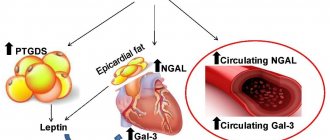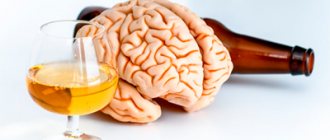Is it possible to teach our brain to artificially produce the “happiness hormone” - serotonin? This task is not easy, but feasible, because managing the delicate hormonal balance is within the power of any person. You just need to want it - and literally in 5 minutes you will be in a great mood and ready to “move mountains.” Hormones of pleasure and happiness will help you in this endeavor:
- serotonin - it is called the hormone of happiness, which gives a feeling of euphoria;
- dopamine – it is responsible for pleasure and reinforces positive experiences;
- Oxytocin - it gives rise to feelings such as love, tenderness and affection.
Most often, this “trinity” works in tandem, forming all our positive emotions. But now we will talk specifically about serotonin. Many people already know the name of this hormone of joy and happiness. But not everyone understands how it works. And even fewer people know how to regulate the level of this hormone in the body.
How to learn to manage serotonin?
This neurotransmitter, which regulates our mood, is not as simple as it might seem at first glance. Surely you think that serotonin is another hormone that is produced in the human brain. This is true, but only partly. Here are the hard facts: 95% of serotonin is produced in the intestines. And only 5% is in the brain.
So really, the path to our happiness lies through the stomach? And this is not entirely true. Serotonin is a complex chemical substance, a derivative of the amino acid tryptophan and, concurrently, the manager of our brain. This hormone is responsible for a wide range of processes both in the brain itself and throughout the human body:
- Serotonin in the brain helps nerve cells communicate better.
- The joy hormone affects sleep and appetite, muscle condition and body function, character and mood.
- The most important neurotransmitter affects cognitive functions (attention, memory, communication, etc.).
- Serotonin is responsible for normal blood clotting and stable functioning of the circulatory system.
- The joy hormone helps us experience interest and attraction to the opposite sex.
Interaction of serotonin with serotonergic receptors
According to modern concepts, S. influences the functions of various organs and tissues by interacting with specific serotonergic receptors that are sensitive to it, which, apparently, are among the membrane-type chemoreceptors. Using pharmacological research methods (the use of S. antagonists), three types of cellular receptors sensitive to S. have been identified. They are designated D-, M-, and T-serotonergic receptors.
D-serotonergic receptors, which are blocked by lysergic acid diethylamide (see) and dibenzyline, are localized mainly in the smooth muscles of internal organs. S.'s interaction with these receptors is accompanied by contractions of smooth muscles. M-serotonergic receptors are blocked by morphine and certain other substances. They are located ch. arr. in the autonomic ganglia. By influencing these receptors, S. causes a ganglion-stimulating effect. T-serotonergic receptors (blocked by tipindole) are found in the cardiopulmonary reflexogenic zone. Acting on them, S. causes coronary and pulmonary chemoreflexes. Both D- and M-serotonergic receptors are found in the brain. It is assumed that in c. n. With. There are also T-serotonergic receptors. S.'s interaction with specific receptors is accompanied by activation of adenylate cyclase, which leads to an increase in the intracellular formation of cyclic adenosine monophosphate. In certain organs (for example, in the smooth muscles of the intestine), under the influence of S., the formation of cyclic guanosine monophosphate increases.
What happens if serotonin levels are disrupted?
Very often we hear about how low levels of the happiness hormone are bad. But the human body is harmed not only by a deficiency, but also by an excess of serotonin. In other words, any disruption in the production of this neurotransmitter provokes a whole list of negative consequences and conditions:
- bad mood and chronic depression;
- a sharp decrease in sexual desire;
- problems with digestion and sleep;
- cravings for sweets and weight gain;
- decreased activity.
The problems listed above are just the tip of the iceberg. The work of serotonin, based on two substances - the amino acid tryptophan and its derivative 5-hydroxytryptophan, is very complex. Sometimes the hormonal imbalance is so pronounced that specialists have no choice but to prescribe antidepressants - serotonin reuptake inhibitors.
The role of serotonin in the activity of the nervous system
In c. n. With. serotonin plays the role of a mediator of synaptic transmission of nerve impulses (see Mediators). The idea of the mediator function of S. was first expressed by Brodie and Shore (V.V. Brodie, PA Shore, 1957) based on data on the presence in the brain of animals and humans of a specific system of neurons that synthesize S. The S. formed in these neurons moves along the axons, reaches their terminus and, released from the latter, interacts with the serotonergic receptors of other neurons.
The main number of synthesizing neurons is located in the raphe nuclei (nuclei raphe), located in the central part of the midbrain and medulla oblongata. The presence of S. in these nuclei, their localization and connections with other parts of the c. n. With. established by Swedish scientists Dahlstrom and Fuxe (A. Dahlstrom, K. Fuxe, 1964) using histochemical research methods. They also proposed a classification of nuclei containing serotonin-synthesizing neurons, according to the cut there are 9 such nuclei in the brain. These nuclei are designated by the Latin letter B with the corresponding digital indices. The most caudally located pale (B1) and dark (B2) nuclei are located in the medulla oblongata. They give rise to axons descending to the spinal cord, the endings of which are distributed segmentally throughout its entire length. The most rostrally located dorsal (B7) and median (B8) raphe nuclei are located in the midbrain and give rise to ascending serotonergic pathways going to the diencephalon and telencephalon. The neurons of the remaining nuclei have short axons ending in the structures of the brain stem and cerebellum. The neurons of the listed nuclei, the axons extending from them and their terminals are considered as a specific serotonergic system of the brain, anatomically connected with its other parts.
Two main serotonergic pathways have been described: mesolimbic (from nucleus B8 to the hippocampus, hypothalamus, septum and limbic cortex) and mesostriatal (from nucleus B7 to the striatum, thalamus, hypothalamus and neocortex). The terminals of these paths in these structures are distributed unevenly. Thus, in the neocortex there is an increase in their density from the lower to the upper layers and a predominance of axodendritic contacts over axosomatic ones, which is characteristic of nonspecific brain structures.
Using the electron microscopic method, it was established that these contacts are represented by varicose dilatations of non-myelinated fibers containing S granules. In this regard, it is assumed that S released from them can have a distant effect on neighboring formations. This organization of contacts of serotonergic terminals creates the possibility of a modulating influence of serotonergic brain structures on the activity of cortical neurons and the nature of their responses to signals arriving along specific afferent pathways coming from the sense organs, which determines the participation of these structures in the processes of perception, processing and fixation of information. The presence of these influences was confirmed using electrophysiology. research methods. It has been established, for example, that S. has an effect on brain potentials evoked by sensory stimuli. Features of the organization of the serotonergic system of the brain and its broad connections with other parts of the c. n. With. determine the participation of this system in the regulation of many body functions and complex forms of behavior. In this case, the relationship between the serotonergic system of the brain and the neurosecretory nuclei of the hypothalamus (see), which have the closest anatomical and functional relationship to the pituitary-adrenal system, plays an important role.
The serotonergic system of the brain is involved in the regulation of the general level of activity of c. n. pp., sleep-wake cycles, general motor activity, various forms of emotional behavior, memory and learning processes. In this case, the interaction of the serotonergic system of the brain with its other neurotransmitter systems, including the nordrenergic system, is very important. Thus, the modulating influences of the serotonergic and noradrenergic systems of the brain, which increase with increasing emotional stress, are essential for information processing. The release of S. from the terminals enhances the circulation of excitation in neural systems associated with the perception and fixation of information, and promotes the transition of the neurodynamic phase of fixation of memory traces into the phase of structural and metabolic changes, i.e., the transformation of short-term memory into long-term, taking part in the regulation of the emotional state , S. plays a big role in the formation of emotional memory (see).
The combined influences of the serotonergic and noradrenergic systems of the brain largely determine the phase structure of sleep (see), i.e., the ratio of slow-wave and paradoxical phases of sleep. In this case, the serotonergic system has a predominant relationship with the organization of the slow-wave phase of sleep. In animals, an increase in the activity of serotonergic brain structures within physiological limits is accompanied by a decrease in the general level of motor and orientation-sequential activity. In humans, when taking tryptophan (the main source of S.), there is a deepening of sleep and a decrease in motor activity.
The serotonergic system of the brain is involved in the regulation of sexual behavior. It has been established that an increase in the level of S. in the brain is accompanied by inhibition of sexual activity, and a decrease in the content of serotonin in the c. n. With. leads to its increase. Animal experiments also established that the serotonergic system of the brain takes part in the regulation of aggressive states. This is evidenced by the fact that a decrease in its activity by local destruction of the midbrain raphe nuclei or with the help of pharmacol. agents that inhibit S.'s biosynthesis are accompanied by an increase in aggressiveness, and an increase in S.'s level in the brain is accompanied by a weakening of it.
The serotonergic system of the brain obviously takes part in the regulation of pain perception (see), because pain sensitivity in animals decreases with an increase in the serotonin content in c. n. pp., and when S.’s biosynthesis in the brain is inhibited (for example, after the administration of p-chlorophenylalanine) it increases. From the content of serotonin in c. n. With. The degree of severity of the analgesic effect of morphine and other narcotic analgesics also depends. It has been established, for example, that against the background of an increase in S. content in the brain, the analgesic effect of morphine intensifies and lengthens. When the biosynthesis of serotonin in the c. is inhibited. n. With. the analgesic effect of morphine is weakened. Based on these facts, it is assumed that S., along with endogenous opioid peptides (see Endogenous opioids), is involved in the regulation of the functions of the so-called. antinociceptive system of the brain, weakening the perception of pain. In addition, there is evidence indicating the influence of the serotonergic system of the brain on the excitability of vasomotor and thermoregulatory centers, as well as the vomiting center. S.’s influence on the functions of certain endocrine glands is apparently due not only to its direct action, but also to central mechanisms, since terminals of serotonergic neurons were found in the subtubercular region of the brain, stimulation of which is accompanied by increased release of corticoliberin (see Hypothalamic neurohormones), prolactin (see) and growth hormone (see).
The role of S. in the regulation of the functions of the peripheral nervous system has been little studied. It is only known that S. enhances the transmission of nerve impulses in the autonomic ganglia, and also increases their response to electrical stimulation of preganglionic fibers and the introduction of ganglion-stimulating substances, for example, acetylcholine. The described effects are due to S.'s interaction with M-serotonergic receptors localized in the autonomic ganglia (see Autonomic nervous system).
But is it worth using “heavy artillery” right away?
We know that antidepressants work quickly. But we also know that they have a lot of disadvantages, the most important of which are addiction and various side effects that can seriously undermine already weakened health. The image below shows how hard antidepressants work. It’s worth thinking about whether such radical measures are necessary???
Is there a safe alternative to pills? Eat. This is the right way of life and the ability to look at the world positively. The “recipe” for your happiness will not consist of a set of drugs, but of completely different components:
- Nutrition. Healthy foods contain everything you need to produce the hormone serotonin in sufficient quantities. Give up fast carbohydrates and junk food in favor of healthy carbohydrates and foods containing tryptophan. Serotonin “grows” on variety: grains and cereals, vegetables and fruits, eggs and dairy products, lean meat and fatty fish, nuts, seeds and dried fruits.
The image shows foods rich in tryptophan.
- Movement. Scientists have repeatedly proven that any physical activity quickly (literally in 30-40 minutes) increases the level of serotonin in the blood. Dancing, walking, swimming, cycling, morning jogging - there are many activities, you don’t have to go to the gym. But there is one “but”: you need to be active constantly, and not from time to time.
- Sleep and meditation. A happy person knows how to “switch off” in time and let go of negativity from his life. Sometimes this is difficult to do. And then meditation and healthy sleep come to the rescue, during which the level of the happiness hormone also increases. Train yourself to go to bed and get up at the same time - and you will not have problems with serotonin.
- More sun. In our climate, sunny days are a rare occurrence. But even on a cloudy day, our skin still receives its portion of ultraviolet radiation. This means that the answer to the question “how to increase serotonin” is simple: walk more often. Walking will give the body maximum happiness hormone and beneficial vitamin D.
- Omega-3. It is difficult for us to maintain an optimal level of essential polyunsaturated fatty acids, which are found in excess only in the meat of fatty fish from the northern seas. But now there is already a worthy alternative - dietary supplement complexes with Omega-3. Such supplements are a real “delicacy” for the brain and prevent a number of diseases.
- Pleasure. Serotonin is responsible for pleasure and enjoyment. How can you get more of these emotions? There are a lot of ideas: for example, falling in love, finding a new exciting hobby, meeting friends more often, spending more time with loved ones. The more bright emotions and positivity there are in your life, the higher the level of the happiness hormone will be.
- "Helpers." Unfortunately, even with proper nutrition, it is not possible to obtain from food 100% of the substances necessary to nourish the brain and body. And then “serotonin in tablets” comes to the rescue. These are special plant vitamin complexes that help the happiness hormone be produced correctly and in the required volume.
Serotonin metabolism
In the body, Serotonin is formed from tryptophan (see), which is first hydroxylated under the influence of tryptophan hydroxylase to form 5-hydroxytryptophan (the rate-limiting stage). Then, under the influence of decarboxylase, 5-hydroxytryptophan is decarboxylated and converted into C. Normally, approx. is consumed for the formation of C. 1 - 3% of tryptophan entering the body with food, with carcinoid - up to 60%, which causes hyperserotoninemia and signs of carcinoid syndrome. Synthesized S. accumulates in cellular depots in the form of granules (up to 75%) and in free form (up to 25%).
The main way of destruction of S. is oxidative deamination under the influence of MAO (see Monoamine oxidases). The resulting 5-hydroxyindolylacetaldehyde is oxidized under the influence of aldehyde dehydrogenase into 5-hydroxyindolylacetic acid, which is excreted by the kidneys (normally an average of 5.0 ± 0.65 mg per day). MAO activity is highest in cells containing S. A small part of S. undergoes N-acetylation. In the pineal gland, N-acetylserotonin is first formed from S., which is converted under the influence of oxyindole-0-methyl-transferase Ch. arr. c N-acetyl-5-methoxytryptamine - melatonin (see), which is considered as a hormone of the pineal gland. In addition, other indoles are formed in the pineal gland, for example. 5-hydroxytryptopol, 5-methoxytryptopol. Activation of the N-acetylation enzyme is mediated by beta-adrenergic receptors.
Ethanol and reserpine can enhance the process of reduction of 5-hydroxyindolylacetaldehyde to 5-hydroxytryptopol that occurs with the participation of aldehyde reductase. However, only approx. 1% 5-hydroxyindolylacetaldehyde. In some tissues, S. can be metabolized in small quantities by N-methylation with the participation of the enzyme indoleamine-N-methyltransferase, found in human lung and brain tissue, resulting in the formation of bufotenine (N, N-dimethyltryptamine) in the body. having hallucinogenic properties. In addition, S.'s metabolites from among 5-hydroxyindoles can undergo further transformations under the influence of a decyclizing enzyme and transamination (see Transamination), resulting in the formation of colored S. metabolic products.
One of the biological mechanisms for maintaining an optimal level of physiologically active S. in the body is serotoninopexy (see).
How do vitamins for a good mood work?
Unlike antidepressants, which inhibit serotonin reuptake, plant-based vitamins act differently—more gently. They bring all neurotransmitters into balance and help the happiness hormone be produced in the right quantity without causing serious harm to the human body:
- fight fatigue and irritability;
- increase memory, attention and concentration;
- eliminate insomnia and other sleep disorders;
- protect against depression and nervous disorders;
- restore interest in life and normalize appetite.
Constant stress at work and at home does not allow you to always be at the peak of activity. But now this problem can be easily solved: just one capsule of herbal vitamins a day - and it will be much easier for you to cope with the challenges that this world has prepared for you. Forgetfulness, absent-mindedness and apathy will be replaced by cheerfulness and a positive mood.
Managing happiness hormones is easy!
The secret to the effectiveness of herbal vitamins for mood is in the ideal composition. There is nothing superfluous in them besides the active components - extracts of medicinal herbs. For example, these could be:
- St. John's wort and clover grass;
- Rhodiola rosea and valerian;
- volodushka and muira puama bark.
Such vitamins, even with long-term use, often turn out to be more effective and safe in comparison with synthetic drugs and antidepressants, which cause addiction, withdrawal effects, drowsiness and other side effects.
Now you know how to properly increase the level of serotonin in the body so that a positive result is not long in coming. Allow the happiness hormone to be produced in full - and your life will become bright, and every day will bring maximum benefit and pleasure.
Physicochemical properties and methods of determination
In the form of a free base, S. is an odorless white powder, slightly soluble in methyl and 95% ethyl alcohol. Insoluble in absolute ethyl alcohol, pyridine, chloroform, ethyl acetone, ether, gasoline; t°melt 209-212°; they say weight (mass) 176.2. At pH 5.4, an aqueous solution of serotonin has absorption maxima at 275 and 293 μm. At pH 4.0, irradiation of serotonin solutions with ultraviolet light with a wavelength of 295 microns causes fluorescence with a maximum in the region of 550 microns.
Due to the fact that S. is unstable in the form of a free base, it is isolated in the form of various salts (for example, picric, adipic, salicylic, etc.) or in the form of a creatinine-sulfate complex. The latter is a light yellow, odorless, crystalline powder. Soluble in water, butanol, heptane, acetone, ice vinegar; t°melt 207 - 216°; they say weight (mass) 405.
To determine Serotonin in tissues, use chap. arr. histochemical research methods
(see), based on the reduction of ammonia silver, reaction with diazonium salts or chromaffin reaction, as well as on the excitation of fluorescence (see): bluish in unfixed sections or golden-yellow in formaldehyde-fixed sections. In biol. S. in liquids is determined using biological, chemical, chromatographic and fluorimetric methods (see Fluorimetry, Chromatography). In wedge, practice, for example, when diagnosing carcinoid syndrome (see Carcinoid), the level of C. biosynthesis in the body is usually assessed by determining the amount of 5-hydroxyindoles or the content of 5-hydroxyindolyl acetic acid in the urine.










